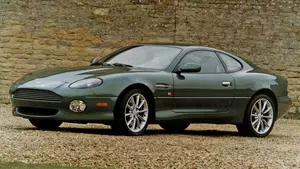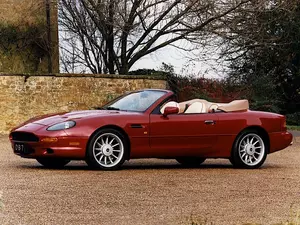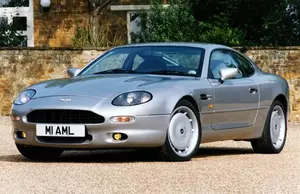
| Engine | 0—60 mph | 0—100 km/h | Top Speed | Averange Economy |
|---|---|---|---|---|
| 5.9 i V12 48V | 4.7 s | 4.9 s | 185 mph | - |
| Engine | 5.9 i V12 48V |
|---|---|
| 0—60 mph | 4.7 s |
| 0—100 km/h | 4.9 s |
| Top Speed | 185 mph |
| Averange Economy | - |
In 2002 Aston Martin DB7 0-60 acceleration was 4.7 seconds.
Aston Martin DB7 0-60 mph was up to 51% faster in 2002 than world's average.
In 2002, Aston Martin DB7 0-60 mph to car weight ratio is shown below:
| Vehicle | Acceleration 0—60 mph (0—100 km/h) | Maximum speed | Acceleration to passenger ratio | Fuel consumption at high speed | Fuel type / gearbox |
|---|---|---|---|---|---|
| 5.9 i V12 48V | 4.7 s to 60 mph (4.9 s to 100 km/h) | 185 mph (298 km/h) | 2.4 s to 60 mph / person | 14 mpg (16.5 L per 100 km) | Petrol (Gasoline) |
| Vehicle | 5.9 i V12 48V |
|---|---|
| Acceleration 0-60 mph (0-100 km/h) | 4.7 s to 60 mph (4.9 s to 100 km/h) |
| Maximum speed | 185 mph (298 km/h) |
| Acceleration to passenger ratio | 2.4 s to 60 mph / person |
| Fuel consumption at high speed | 14 mpg (16.5 L per 100 km) |
| Fuel type / gearbox | Petrol (Gasoline) |

| Engine | 0—60 mph | 0—100 km/h | Top Speed | Averange Economy |
|---|---|---|---|---|
| 5.9i V12 48V | 4.8 s | 5 s | 185 mph | - |
| Engine | 5.9i V12 48V |
|---|---|
| 0—60 mph | 4.8 s |
| 0—100 km/h | 5 s |
| Top Speed | 185 mph |
| Averange Economy | - |
In 1999 Aston Martin DB7 0-60 acceleration was 4.8 seconds.
Aston Martin DB7 0-60 mph was up to 50% faster in 1999 than world's average.
In 1999, Aston Martin DB7 0-60 mph to car weight ratio is shown below:
| Vehicle | Acceleration 0—60 mph (0—100 km/h) | Maximum speed | Acceleration to passenger ratio | Fuel consumption at high speed | Fuel type / gearbox |
|---|---|---|---|---|---|
| 5.9i V12 48V | 4.8 s to 60 mph (5 s to 100 km/h) | 185 mph (298 km/h) | 2.4 s to 60 mph / person | 24 mpg (10 L per 100 km) | Petrol (Gasoline) / 5 |
| Vehicle | 5.9i V12 48V |
|---|---|
| Acceleration 0-60 mph (0-100 km/h) | 4.8 s to 60 mph (5 s to 100 km/h) |
| Maximum speed | 185 mph (298 km/h) |
| Acceleration to passenger ratio | 2.4 s to 60 mph / person |
| Fuel consumption at high speed | 24 mpg (10 L per 100 km) |
| Fuel type / gearbox | Petrol (Gasoline) / 5 |

| Engine | 0—60 mph | 0—100 km/h | Top Speed | Averange Economy |
|---|---|---|---|---|
| 5.9i V12 48V | 4.8 s | 5 s | 165 mph | 13 mpg |
| 3.2 V6 | 5.7 s | 6 s | 165 mph | - |
| Engine | 5.9i V12 48V |
|---|---|
| 0—60 mph | 4.8 s |
| 0—100 km/h | 5 s |
| Top Speed | 165 mph |
| Averange Economy | 13 mpg |
| Engine | 3.2 V6 |
| 0—60 mph | 5.7 s |
| 0—100 km/h | 6 s |
| Top Speed | 165 mph |
| Averange Economy | - |
In 1996, Aston Martin DB7 0-60 acceleration was between 4.8 and 5.7 seconds.
Aston Martin DB7 0-60 mph was up to 50% faster in 1996 than world's average.
In 1996, Aston Martin DB7 0-60 mph to car weight ratio is shown below:
| Vehicle | Acceleration 0—60 mph (0—100 km/h) | Maximum speed | Acceleration to passenger ratio | Fuel consumption at high speed | Fuel type / gearbox |
|---|---|---|---|---|---|
| 5.9i V12 48V | 4.8 s to 60 mph (5 s to 100 km/h) | 165 mph (266 km/h) | 2.4 s to 60 mph / person | 24 mpg (10 L per 100 km) | Petrol (Gasoline) / 5 |
| 3.2 V6 | 5.7 s to 60 mph (6 s to 100 km/h) | 165 mph (265 km/h) | 2.9 s to 60 mph / person | - | Petrol (Gasoline) / 4 |
| Vehicle | 5.9i V12 48V |
|---|---|
| Acceleration 0-60 mph (0-100 km/h) | 4.8 s to 60 mph (5 s to 100 km/h) |
| Maximum speed | 165 mph (266 km/h) |
| Acceleration to passenger ratio | 2.4 s to 60 mph / person |
| Fuel consumption at high speed | 24 mpg (10 L per 100 km) |
| Fuel type / gearbox | Petrol (Gasoline) / 5 |
| Vehicle | 3.2 V6 |
| Acceleration 0-60 mph (0-100 km/h) | 5.7 s to 60 mph (6 s to 100 km/h) |
| Maximum speed | 165 mph (265 km/h) |
| Acceleration to passenger ratio | 2.9 s to 60 mph / person |
| Fuel consumption at high speed | - |
| Fuel type / gearbox | Petrol (Gasoline) / 4 |

| Engine | 0—60 mph | 0—100 km/h | Top Speed | Averange Economy |
|---|---|---|---|---|
| 3.2 V6 | 5.7 s | 6 s | 165 mph | - |
| Engine | 3.2 V6 |
|---|---|
| 0—60 mph | 5.7 s |
| 0—100 km/h | 6 s |
| Top Speed | 165 mph |
| Averange Economy | - |
In 1994 Aston Martin DB7 0-60 acceleration was 5.7 seconds.
Aston Martin DB7 0-60 mph was up to 40% faster in 1994 than world's average.
In 1994, Aston Martin DB7 0-60 mph to car weight ratio is shown below:
| Vehicle | Acceleration 0—60 mph (0—100 km/h) | Maximum speed | Acceleration to passenger ratio | Fuel consumption at high speed | Fuel type / gearbox |
|---|---|---|---|---|---|
| 3.2 V6 | 5.7 s to 60 mph (6 s to 100 km/h) | 165 mph (265 km/h) | 2.9 s to 60 mph / person | - | Petrol (Gasoline) / 4 |
| Vehicle | 3.2 V6 |
|---|---|
| Acceleration 0-60 mph (0-100 km/h) | 5.7 s to 60 mph (6 s to 100 km/h) |
| Maximum speed | 165 mph (265 km/h) |
| Acceleration to passenger ratio | 2.9 s to 60 mph / person |
| Fuel consumption at high speed | - |
| Fuel type / gearbox | Petrol (Gasoline) / 4 |